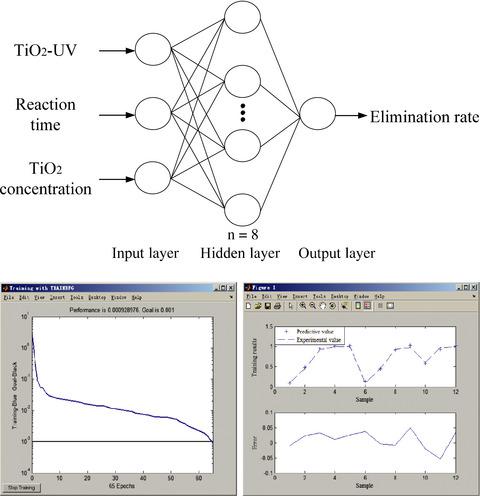当前位置:
X-MOL 学术
›
Food Sci. Nutr.
›
论文详情
Our official English website, www.x-mol.net, welcomes your
feedback! (Note: you will need to create a separate account there.)
Structural characterization and catalytic sterilization performance of a TiO2 nano-photocatalyst.
Food Science & Nutrition ( IF 3.5 ) Pub Date : 2020-06-01 , DOI: 10.1002/fsn3.1646 Yue Yang 1, 2 , Chengli Guan 1 , Shanyuan Chen 1
Food Science & Nutrition ( IF 3.5 ) Pub Date : 2020-06-01 , DOI: 10.1002/fsn3.1646 Yue Yang 1, 2 , Chengli Guan 1 , Shanyuan Chen 1
Affiliation

|
In view of the food safety and hygiene issues caused by pathogenic microorganisms, tetrabutyl titanate was used as a precursor for the preparation of a TiO2 nano‐semiconductor photocatalyst via the sol–gel process. The plate count method was then adopted to investigate the photocatalytic sterilization performance of the synthesized TiO2 nanoparticles toward Escherichia coli, Staphylococcus aureus, and Candida albicans. Subsequently, a backpropagation (BP) neural network model was developed to predict the photocatalytic sterilization performance. The photocatalyst was structurally characterized by the Brunauer–Emmett–Teller method for specific surface area determination, transmission electron microscopy, X‐ray diffraction, and X‐ray photoelectron spectroscopy. The results indicated that the prepared TiO2 nano‐photocatalyst was of high purity with a specific surface area of 76.5 m2/g and the particle size range 15–18 nm. The nanoparticles exhibited characteristic peaks corresponding to the oxide component Ti–O, hydroxyl group ˙OH and oxygen chemisorbed and presented an anatase‐dominated multiphase structure that enhanced the photocatalytic performance. UV irradiation at 254 nm produced better sterilization effects on E. coli, S. aureus, and C. albicans, with elimination rates after 30 min of reaction of 97.8%, 99.4%, and 93.6%, respectively. These results indicated that the TiO2 nano‐photocatalyst is a promising environmentally friendly catalyst with good sterilization performance. The constructed BP neural network also exhibited high training accuracy and good generalization ability, with correlation coefficients between the network‐predicted and experimental target values of 0.9789. These results support research on the intelligent processing of photocatalytic sterilization with TiO2 nanoparticles.
中文翻译:

TiO2 纳米光催化剂的结构表征和催化灭菌性能。
针对病原微生物引起的食品安全和卫生问题,以钛酸四丁酯为前驱体,通过溶胶-凝胶法制备TiO 2纳米半导体光催化剂。采用平板计数法考察了合成的TiO 2纳米粒子对大肠杆菌、金黄色葡萄球菌和白色念珠菌的光催化杀菌性能。随后,开发了反向传播(BP)神经网络模型来预测光催化灭菌性能。通过 Brunauer-Emmett-Teller 比表面积测定法、透射电子显微镜、X 射线衍射和 X 射线光电子能谱对光催化剂进行了结构表征。结果表明,所制备的TiO 2纳米光催化剂纯度较高,比表面积为76.5 m 2 /g,粒径范围为15~18 nm。纳米粒子表现出与氧化物组分Ti-O、羟基˙OH和化学吸附的氧相对应的特征峰,并呈现出以锐钛矿为主的多相结构,增强了光催化性能。 254 nm紫外线照射对大肠杆菌、金黄色葡萄球菌和白色念珠菌有较好的杀菌效果,反应30 min后消除率分别达到97.8%、99.4%和93.6%。这些结果表明TiO 2纳米光催化剂是一种有前途的环境友好型催化剂,具有良好的杀菌性能。 构建的BP神经网络还表现出较高的训练精度和良好的泛化能力,网络预测值与实验目标值之间的相关系数为0.9789。这些结果支持了TiO 2纳米颗粒光催化灭菌智能处理的研究。
更新日期:2020-06-01
中文翻译:

TiO2 纳米光催化剂的结构表征和催化灭菌性能。
针对病原微生物引起的食品安全和卫生问题,以钛酸四丁酯为前驱体,通过溶胶-凝胶法制备TiO 2纳米半导体光催化剂。采用平板计数法考察了合成的TiO 2纳米粒子对大肠杆菌、金黄色葡萄球菌和白色念珠菌的光催化杀菌性能。随后,开发了反向传播(BP)神经网络模型来预测光催化灭菌性能。通过 Brunauer-Emmett-Teller 比表面积测定法、透射电子显微镜、X 射线衍射和 X 射线光电子能谱对光催化剂进行了结构表征。结果表明,所制备的TiO 2纳米光催化剂纯度较高,比表面积为76.5 m 2 /g,粒径范围为15~18 nm。纳米粒子表现出与氧化物组分Ti-O、羟基˙OH和化学吸附的氧相对应的特征峰,并呈现出以锐钛矿为主的多相结构,增强了光催化性能。 254 nm紫外线照射对大肠杆菌、金黄色葡萄球菌和白色念珠菌有较好的杀菌效果,反应30 min后消除率分别达到97.8%、99.4%和93.6%。这些结果表明TiO 2纳米光催化剂是一种有前途的环境友好型催化剂,具有良好的杀菌性能。 构建的BP神经网络还表现出较高的训练精度和良好的泛化能力,网络预测值与实验目标值之间的相关系数为0.9789。这些结果支持了TiO 2纳米颗粒光催化灭菌智能处理的研究。











































 京公网安备 11010802027423号
京公网安备 11010802027423号